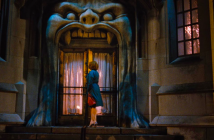
La Dolce Vita (1960)
Cast: Marcello Mastroianni, Anita Ekberg, Anouk Aimée
Director: Federico Fellini
Country: Italy | France
Genre: Comedy | Drama
Editor’s Notes: La Dolce Vita was released on Criterion Blu-ray on October 21st.
Equally a caustic encapsulation of celebrity culture and a confessional of one’s more-cultivating-than-complicit role in it, Federico Fellini’s La dolce vita is the work of an artist at odds not with the professional system in which he works but with the state of cultural decline that certain parasitic vocations – his lead and likely self-depreciating surrogate Marcello Rubini (Marcello Mastroianni) is a freshman novelist-cum-respected journalist-cum-tabloid sensationalist – have encouraged. Played up throughout and to great effect, a selectively featured Roman cityscape that’s saturated artistically and adorned with landmarks numerous becomes a playground for the famed, those of certain class privilege that treat the area not with historic reverence but flippant novelty; the film’s characters favor the present’s delights over the past’s dignity. Time and time again, the curtain of deep night rises and is followed, as is customary, by the incendiary crawl of dawn, with the sobering light of day ultimately making its unwelcomed presence known, and this circadian rhythm repeats unto itself in La dolce vita as Marcello and his cronies wallow in the backdrop of the decaying Eternal City.
Equally a caustic encapsulation of celebrity culture and a confessional of one’s more-cultivating-than-complicit role in it, Federico Fellini’s La dolce vita is the work of an artist at odds not with the professional system …
Jesus is the first face we’re shown in the film. Larger than life, a resplendent statue of the religious icon dangles perilously from a helicopter, hovering high above all that the city houses – the ruins, the socialites, the slums – as if to juxtapose the area’s spiritual priority against its economic disparity. Further, this opening scenario sensationalizes the figure’s image, a motif that is on display throughout the remainder of the film: Our obsession with individual achievement and éclat causes us to commodify the person, globally, into a representation rather than a human. Marcello, for instance, abdicated the nobler work of literary author to pursue reporting on issues of celebrity. Flanked by his trusty cameraman Paparazzo (Walter Santesso),the self-proclaimed “journalist” is quick to expose the goings on of the local glitterati, especially in concerns of the lurid and sordid varieties. Even worse is how throughout the film Marcello encounters a number of women with whom, at one time or another, he’s propositioned sex from in exchanged for exposure in his magazine.

Thus is the problem of reading Rubini as an avatar for the filmmaker himself, which may come all too naturally to those familiar with Fellini’s penchant for autobiographical flourish and others who’ve merely seen 8 ½: Marcello is an enormous ass, a coward who’s not above striking his fiancé, a man in perpetual lecherous pursuit of several women within his various social spheres. And yet, he’s portrayed as innately cool. He has a chic suit and set of sunglasses for every occasion, his wardrobe, presence, and airs coalescing to form this totem to the fashionable and witty even as straddles the line, at least intellectually, between trash peddler and artist, everyman and elitist. In a sense, his dynamism acts as an invitation for viewers to join him in a pilgrimage of sorts, one that leads through infernal, class-tiered circles of late-50’s and early-60’s Italy and descends, ultimately, into a state of complete moral disregard.
Except that it really doesn’t. While the persona of Marcello acts assuredly as a nexus between audience and artist, fantasy and reality, he’s more than a mere spectator to the episodically cadenced events that befall him throughout the film, the elaborate dioramas that showcase the country’s cultural failings during the post-war epoch; no, Marcello is not a victim of these circumstances but one of its chief architects. It is by his design that one of the film’s many lamentations, that individuals can either access the privacy that poverty affords or suffer the detached intimacy of wealth, comes to be actualized. By proxy, other mediums of interpersonal dependence like film inherently create or draw attention to the single person, such as an actor/actress and/or director/writer, which further catalyzes a societal celebrity craze. But this reads as an unfortunate byproduct bore of natures both human and cinematic that can’t wholly be avoided – movies continue to be made due in part to the consumerist model of the industry. Conversely, Marcello’s work as guttersnipish wordsmith (funny, though, how we only once ever see him writing, but he’s always “researching,” experiencing) is, by design, an exploitative practice, a subtle slight at capitalist drive that shows how some niche markets, however in demand, needn’t necessarily be filled.
Despite the pervading critical tonality of La dolce vita, it seems that, at times, Fellini obliquely builds in excuses for the actions of some characters (Marcello, especially), as if to say that certain vices, while wrong, are understandable or even expected.
Despite the pervading critical tonality of La dolce vita, it seems that, at times, Fellini obliquely builds in excuses for the actions of some characters (Marcello, especially), as if to say that certain vices, while wrong, are understandable or even expected. In a scene fairly early in the film, our protagonist scoffs at other reporters as they lob mindless, flirtatious questions at actress Sylvia (Anita Ekberg), and he thinks the men fools for their assumptive and objectifying behavior. (The worst offender even casually proffers the phrase “Nice piece of meat, eh?” as if it’s the consensus mindset amongst them.) But it isn’t long before Marcello’s opinions change, as he too falls victim to Sylvia’s charms, fawning over her as if spellbound while her breasts heave from the top of her dress. Such a detail is one of the reasons why I find it fair to infer that the film’s principal is at least partly inspired by the filmmaker himself. From I Vitelloni on, Fellini has made no secret of his weakness for the buxom and turns himself into something of an apologist for those whose constitutions crumble in the presence of the curvaceous. Sure, the actress comes slack-jawed when asked a question about the state of Italian Neorealism – a handler cues her the answer – but who cares because she’s wearing a low-cut dress? It’s possible that Fellini isn’t entirely excusing this behavior, but acknowledging his own flaws. And this would be fine, but it’s done so in something of a trivializing way, made light of because Marcello’s bumbling verbally and physically is a bit comical given his otherwise nonchalant put-on.
And yet for its inconsistencies both ideological and tonal – and unlike other Fellinis, very few ambient shifts take the form of surreality here – there’s a reason why so many regard La dolce vita as a masterpiece. With its magnum scope and giddy abrasiveness, the film does make adept points regarding an entire spectrum of topics from journalistic intrusion (Steiner’s wife at the bus stop) to religious ownership and commodification (the destruction of the “Miracle Tree”) to the exploitation of the willing and naïve (Marcello’s treatment of the “farm girl” near the picture’s end). And moreover, the film is more often than not beautiful. Frames often prioritize depth to depict characters moving away from the camera and deeper into the composition – deeper into the path of supposed cultural collapse. Even for all its vacillations, La dolce vita exists as this chaotic, imperfect entity that somehow manages to feel mostly apropos in showing Fellini’s societal hang-ups, and moreover, in conveying the resignation one feels when surrounded by moral necrosis.
Transfer
Stately and lavish, this restoration of Fellini’s sometimes misdirected censure of period-dependent fixation and excess looks remarkably rich on Blu-ray, boasting great image stability and a fine, homogenous grain. The fine detail present throughout allows for an array of texture, highlighting the minutia of facial expressions and bringing forth the crags of Rome’s aged façade. Minor complaints include intermittent soft shots and “special” effects that now come exposed due to the nuance and otherwise seamlessness of the transfer (the chroma key compositioning of certain scenes is obtrusively balky). The sound track is also quite stable, though some may be distracted by the A/V incongruity that’s an outgrowth of dubbing. Vocalizations and accompanying orchestration feel well-balanced and largely organic, steadying and spacing themselves after the acoustic onslaught of the movie’s opening few scenes.
Stately and lavish, this restoration of Fellini’s sometimes misdirected censure of period-dependent fixation and excess looks remarkably rich on Blu-ray, boasting great image stability and a fine, homogenous grain.



